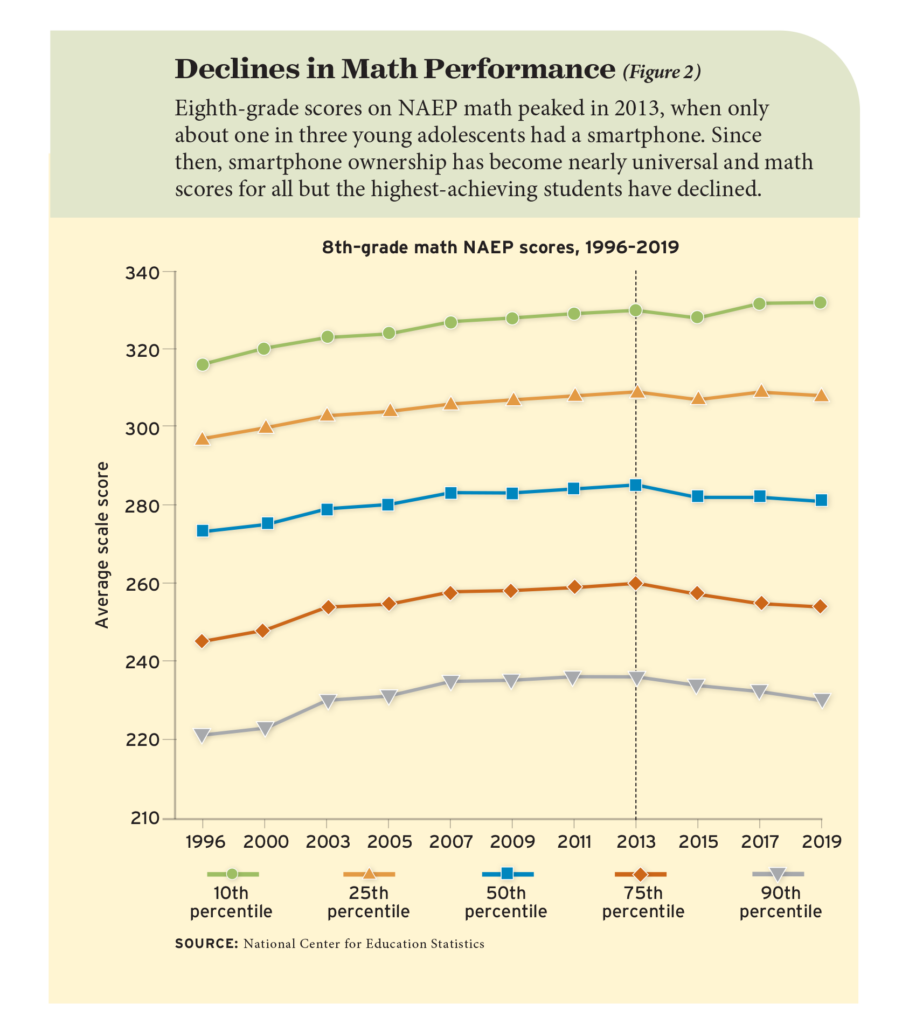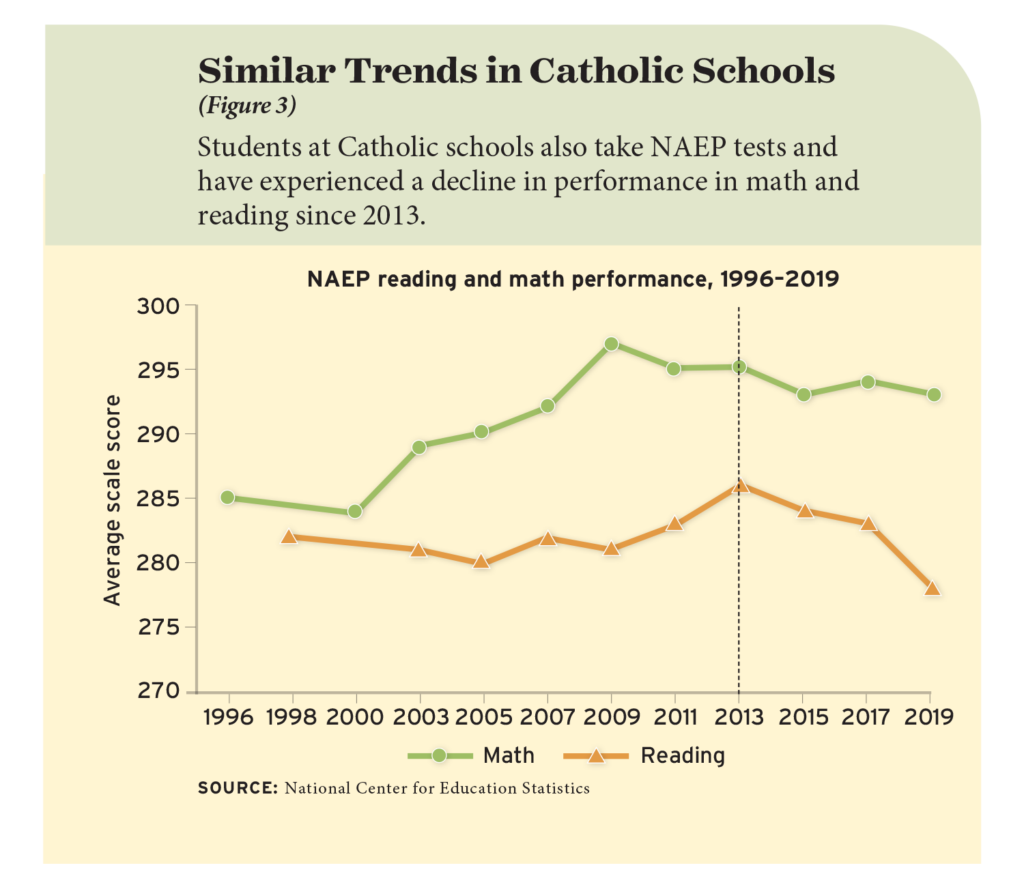Ten years of smartphone prevalence and adverse NAEP tendencies
Understandably, discussions in the education realm often revolve around the implications of artificial intelligence for schools and students. However, amid this technological focus, it’s crucial not to overlook the challenges posed by a previous innovation. Over the past decade, smartphones have become ubiquitous, with a staggering 95 percent of American teenagers carrying a supercomputer in their pocket today.
Renowned figures like Jonathan Haidt and Jean Twenge have shed light on the potential role of smartphones and social media in contributing to a teenage mental health crisis gripping our nation. While establishing a direct causal link in such a widespread phenomenon is challenging, experts note a simultaneous surge in teenage anxiety, depression, and suicidal tendencies, aligning with the period when smartphone adoption among teens surpassed 50 percent around 2012-2013. Particularly concerning is the observation that heavy smartphone and social media use, predominantly among girls and especially liberal girls, coincides with heightened mental health challenges. Similar patterns have surfaced in other countries, underscoring the potential impact of technology on mental well-being.
While I won’t delve into evaluating this evidence extensively, I share the belief that adopting a precautionary stance, assuming smartphones and social media may indeed be harming our youth, is prudent. However, my immediate inquiry centers on whether these technologies might also underlie the stagnation and decline in student achievement in the United States, evident from around 2013, well before the disruptive test score declines brought about by pandemic-related shutdowns.
I don’t attribute our academic struggles solely to smartphones. I’ve previously argued that the Great Recession played a significant role, affecting family circumstances and precipitating substantial budget cuts, especially in high-poverty schools around 2013-2014. Research, notably by Kirabo Jackson, highlights the negative impact of these funding reductions on student achievement. Additionally, shifts away from school accountability, notably the 2012 relaxation of consequences for low test scores under the No Child Left Behind Act, followed by its replacement with the Every Student Succeeds Act in 2015, could have contributed.
Nonetheless, the smartphone hypothesis warrants serious consideration. Unlike economic downturns or pandemic-related disruptions, the trends linked to smartphones persist and continue to rise among adolescents. If smartphone usage indeed affects the learning outcomes compared to the pre-smartphone era, it necessitates urgent attention and exploration.

The alignment in timing becomes conspicuously apparent when considering the data trends (please refer to Figures 1 and 2). Around 2013, there was a notable surge in smartphone ownership among adolescents attending middle and high schools. Intriguingly, this period also marks the zenith of median achievement on the 8th-grade math test as recorded in the National Assessment on Educational Progress (NAEP). Subsequent to this peak, there has been a gradual but perceptible decline in these assessment scores.
Delving deeper into this educational landscape, the decline is particularly accentuated among students positioned at the 10th and 25th percentiles in terms of academic performance. These cohorts of learners, representing our lowest achievers, exhibited a more pronounced and notable decrease in their performance during this time frame. The disparity in the decline between the median achievers and these lowest-performing students underscores a significant shift that aligns with the proliferation of smartphone ownership among adolescents.

Further compelling evidence stems from an examination of Catholic schools, which offer a plausible control group to scrutinize the implications of the smartphone hypothesis (refer to Figure 3). Students in Catholic schools undergo NAEP assessments in math and reading, similar to their counterparts in public schools. However, Catholic schools operate independently of direct influences from shifts in educational policies, such as alterations in federal school-accountability regulations or budget cuts in public-school funding.
Notably, if students in Catholic schools exhibited declines in achievement around the same period, which indeed occurred, particularly noticeable in reading assessments, it suggests that external factors beyond changes in education policy might be contributing to these academic shifts. The analogous decline in achievement within Catholic schools, unaffected by direct policy changes impacting public schools, points towards potential external factors, aligning temporally with the proliferation of smartphones among adolescents.

However, conflicting evidence arises when analyzing the declines in achievement during the 2010s, particularly affecting our lowest-performing students, a demographic disproportionately comprising individuals from marginalized backgrounds—those who are economically disadvantaged, Black, Hispanic, and male. Interestingly, studies highlighted by Haidt and others emphasize that the prevalence of phone and social media use was primarily concentrated among middle-class girls, at least initially, which appears incongruent with these academic trends.
Before advocating for further research, it’s essential to contemplate the potential mechanisms linking smartphone and social media usage to diminished student achievement. One plausible aspect revolves around attention-related challenges. As students adapt to the instant gratification derived from social validation, captivating videos, and engaging platforms like TikTok and YouTube, they may struggle to focus on slower-paced and less visually stimulating educational content encountered in their classrooms and during homework. This dynamic presents challenges for educators attempting to engage students in traditional academic formats.
Moreover, the impact of phones on mental health could be contributing to the academic decline, given the difficulty of learning when experiencing anxiety or depression.
Another factor to consider is the influence on sleep patterns (refer to Figure 4). The correlation between smartphone and social media usage and decreased sleep duration is well-documented. Studies show that children today sleep less compared to the pre-smartphone era, and this reduced sleep duration is associated with deteriorating mental health, further complicating the ability to learn effectively.

The intricate connection between reduced sleep and compromised learning among students is undeniable. Sleep is a pivotal phase during which the brain engages in intricate processes, facilitating the consolidation of information, fortifying neural pathways, and solidifying newly acquired knowledge into the archives of long-term memory. When fatigued, the learning process becomes an uphill struggle. Additionally, students staying up late and missing school due to disrupted sleep patterns further exacerbate the chronic absenteeism crisis prevalent in education.
Given this multifaceted interplay of factors, what actionable steps can we take? Adhering to the precautionary principle, one approach involves advocating for parents to actively manage their tweens’ and teens’ interactions with smartphones and social media. Educators, too, play a vital role by implementing and enforcing classroom guidelines that curtail phone usage, mandating devices to be stowed away except when essential for educational purposes—though this proposition might pose considerable challenges in implementation. While entirely eliminating phone use might seem impractical, legislative proposals that restrict access to social media applications until the age of 16 could potentially offer a means to address this issue.
Schools serve as pivotal advocates for parents to establish reasonable limits on screen time, endorse earlier bedtimes, and mandate the removal of phones from bedrooms during sleep hours. Substantial research bolsters initiatives focused on preserving and enhancing students’ sleep quality, laying the groundwork for discussions and implementations of these measures.
Augmenting the duration of sleep might emerge as a transformative solution—one that not only bolsters academic achievement but also augments mental well-being. This emphasis underscores the crucial need to prioritize fundamental human necessities over technological advancements while contemplating the future implications of AI in education and society. Ultimately, recognizing and tending to these timeless needs of children could wield unparalleled influence in shaping their future trajectories.









